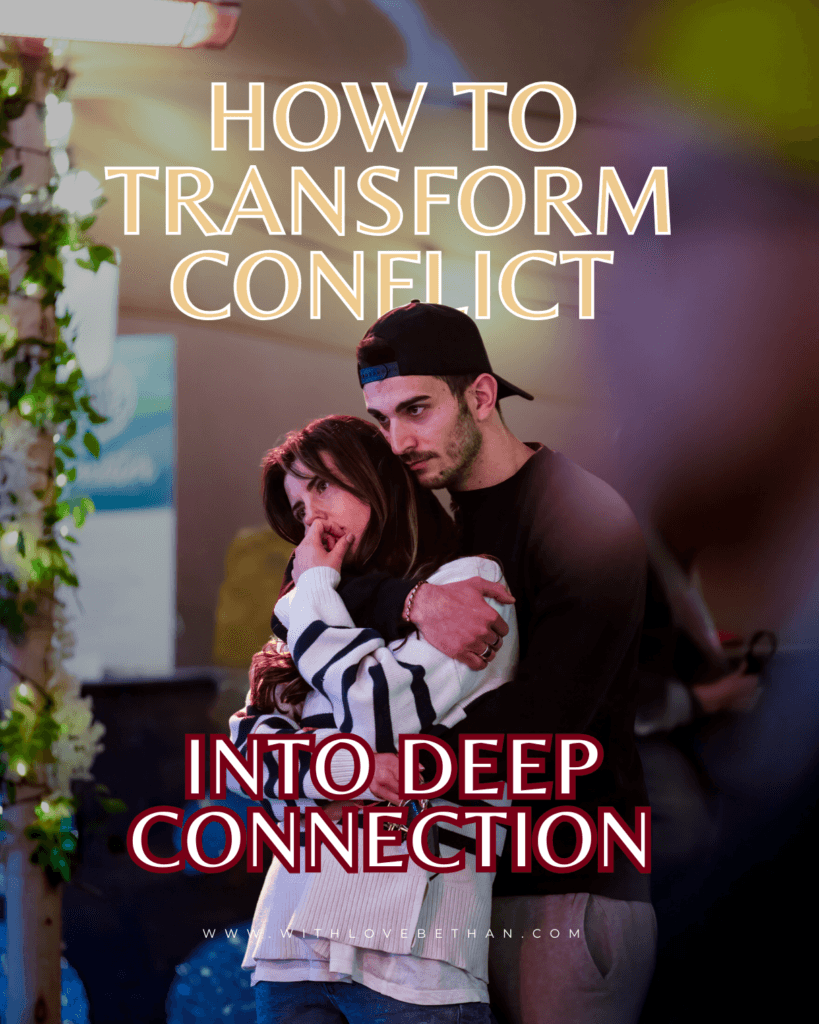
Relationships can be some of the most transformative spaces for personal growth, especially when conflicts arise. When we face ruptures with our partner, we’re often meeting parts of ourselves that long for healing. So, what if instead of seeing these ruptures as setbacks, we could see them as openings? Opportunities to deepen intimacy, and ultimately, to build a relationship that is not only healthy but soul-fulfilling.
For those of us with an anxious attachment style, finding harmony with a partner with an avoidant style can be a journey filled with both vulnerability and breakthroughs. My partner and I just went through one of those growth-heavy periods—a six-week stretch of injury, emotional strain, and intense conversations that brought us to our breaking point and back again. It felt like both an ego death and a quantum leap, leaving us feeling more attuned, more connected, and ready to embrace a whole new reality together.
In this article, I’m sharing what this journey of rupture and repair has taught me about creating a relationship that truly feels like home, plus research-backed insights and actionable strategies for any couple wanting to build a love that lasts.
How Attachment Styles Shape Our Experience of Love and Conflict
Attachment styles are like the invisible scripts running in our minds, guiding how we connect, protect ourselves, and respond to our partner’s needs. For those with an anxious attachment style, closeness often equals security, and distance can trigger fears of abandonment. Conversely, individuals with avoidant attachment may feel easily overwhelmed by closeness, leading them to seek space, especially during stress.
In the last six weeks, I learned just how much attachment dynamics drive the push-and-pull in relationships. Studies show that individuals with anxious attachment can often fall into “protest behaviour”—doing things like caregiving or intensifying closeness when they sense a partner pulling away (Levine & Heller, 2010). This is exactly where I found myself when my partner injured his ankle. As I took on a caregiving role, managing his needs and filling in the gaps, my underlying worry that I wasn’t appreciated began to intensify.
For him, however, my desire to help felt like added pressure. This perception is common in avoidant partners, who may start to feel “smothered” or restricted when their autonomy seems under threat (Simpson & Rholes, 2017). We were, unknowingly, setting off each other’s attachment alarms, and the outcome was a pattern of conflict that needed to be addressed if we were to move forward.
Turning Conflict into Connection: The Power of Rupture and Repair
What I’ve come to realise through both personal experience and attachment research is that ruptures—moments when our connection feels threatened—are actually powerful chances for repair. And repair isn’t just about smoothing things over; it’s about making space for vulnerability, allowing the cracks to show so that we can rebuild with understanding and respect. Research in attachment theory tells us that when partners work through conflict and truly hear each other, they can create what psychologists call a “secure base” in their relationship, a feeling of mutual safety that supports personal growth (Johnson, 2013).
Our repair journey wasn’t a one-off conversation; it was a whole day of hashing out the fears, resentments, and buried needs that had surfaced in the last six weeks. I realised that my caregiving was less about love and more about my need for validation. And he, in turn, realised that his avoidance was a way to shield himself from vulnerability. This mutual ego death—letting go of our well-worn defences—was what ultimately allowed us to reconnect on a deeper level.
It’s been found that securely attached couples are often willing to tolerate each other’s differences and work through ruptures to strengthen their bond (Simpson & Rholes, 2017). Through this experience, we’ve come to understand that rupture and repair are not just hurdles to overcome—they’re the heartbeats of a resilient, soul-connected relationship.
Steps to Transform Conflict and Cultivate Deep, Fulfilling Relationships
If you’re ready to turn your own relationship conflicts into pathways for growth and deeper love, these steps may help you, just as they did for us:
- Cultivate Safe Space for Open Dialogue
Set aside time to talk about difficult feelings in an environment free from distractions. Researchers agree that intentional, non-judgemental conversations are essential for building emotional safety and encouraging openness (Johnson, 2013). We set aside time (a whole day!) to navigate this hard phase we were currently facing, it was uncomfortable and difficult but showing up for each other like this deepened our connection and highlighted how we always choose and decide to be together. - Learn Each Other’s Attachment Patterns
Discover your partner’s attachment triggers and share your own. Knowing that I tend to seek closeness during stress, while my partner needs space, has helped us recognise when we’re falling into predictable patterns. Understanding these styles makes it easier to navigate difficult moments without taking them personally (Gillath, Karantzas, & Fraley, 2016). - Respect Boundaries as Acts of Love
Contrary to what we might feel, setting boundaries can be one of the most loving acts in a relationship. For us, learning to respect each other’s space and individuality has allowed both of us to feel more secure and grounded, which in turn, deepens our connection (Simpson & Rholes, 2017). - Prioritise Self-Care to Avoid Overdependence
Anxiously attached individuals can sometimes rely heavily on their partner for validation and security – this is a space that I fall into and it can feel incredibly hard to navigate the period of not feeling wanted and loved when your partner is taking time for themselves. Taking time for self-care and nurturing your own needs can create emotional balance, reducing the urge to seek constant reassurance (Levine & Heller, 2010). The question I ask myself now from this rupture is, is this a need I can meet myself? if so how? We have to realise that our partner cannot meet every single need, and they can’t be the whole source of life – you have to be your own person too (this is why they fell in love with you at the beginning!). Take time to nurture and discover yourself outside of the relationship too. - Reframe Conflict as Growth
Every rupture can be a turning point, a chance to become a better partner and a better version of yourself. When both partners approach the relationship as a space for mutual growth, the relationship transforms from a source of stress to a source of support (Johnson, 2013). It’s hard in the thick of it but afterwards we both feel like ‘we needed it this’. For breakthroughs to happen, a breakdown needs to happen first so we can catapult forward to the life we desire. Remembering that conflict and repair is growth in the midst of the chaos can help partners become aligned.
Soul-Fulfilling Relationships Are Built Through Conscious Love
What we’re building now, after this rupture, feels like the beginning of a truly conscious relationship. A conscious relationship is one in which both partners commit to growing, not just as a couple but as individuals. These relationships are rooted in the understanding that love isn’t static; it evolves as we evolve.
In fact, research suggests that couples who engage in secure, open communication build a sense of stability in their relationship that acts as a foundation for individual growth. This is what creates a truly fulfilling partnership—a relationship where both people can bring their full selves, be seen, and be loved (Gillath et al., 2016). To me, that’s the magic of repair: learning to love each other, not in spite of our wounds but through them.
Seeking Support: A Path to Deepening Your Relationship Journey
If you’re longing to create a relationship that feels soul-nourishing, working with a therapist can be a transformative step. Therapy allows both partners to explore and understand their attachment patterns, to heal old wounds, and to learn skills for healthier connection. Through this journey, I’ve seen that healing isn’t about fixing each other but about growing together, nurturing a relationship that feels like the safest place to be yourself. Both seeking individual therapy (as well as couples therapy) can be magnificent in transforming this process.
In therapy, we explore the ways in which attachment styles, past traumas, and unmet needs show up in our relationships, and how to transform them into growth opportunities. It’s a chance to cultivate the kind of love that withstands rupture and emerges stronger, the kind of love that truly feels like home.
References
- Gillath, O., Karantzas, G. C., & Fraley, R. C. (2016). Adult Attachment: A Concise Introduction to Theory and Research. Academic Press.
- Johnson, S. M. (2013). Love Sense: The Revolutionary New Science of Romantic Relationships. Little, Brown Spark.
- Levine, A., & Heller, R. (2010). Attached: The New Science of Adult Attachment and How It Can Help You Find—and Keep—Love. TarcherPerigee.
- Simpson, J. A., & Rholes, W. S. (2017). Attachment Theory and Research: New Directions and Emerging Themes. Guilford Publications.
In a world where relationships often mirror the inner work we have left to do, facing conflict with curiosity and intention can turn rupture into rebirth. Each tear and every boundary is an invitation to dive deeper, to see yourself and your partner with fresh eyes, and to build a love that is as healing as it is joyful. I invite you to start your journey today—because the relationship of your dreams may just be waiting on the other side of repair.


